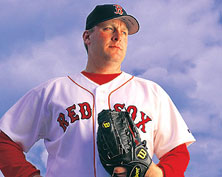
HEAD GAME Curt Schilling credits the best years of his career to the use of a sports psychologist. |
There's a saying in baseball: you can never have too much pitching. If that's the case, you've come to the right place. We sat in on a pitching summit for the ages this past January at Fenway Park, part of the 2011 Hot Stove Cool Music benefit. For more than an hour, Red Sox GM Theo Epstein, Blue Jays manager (and former Sox pitching coach) John Farrell, former Major League All-Star (and current Sox team psychologist) Bob Tewksbury, Red Sox hero Curt Schilling, Red Sox pitcher Rich Hill, and the MLB Network's Peter Gammons chewed the cowhide about pitch counts, balls and strikes, the mental part of the game, getting out of a jam, and more.
The line-up:
Peter Gammons, sportswriter
John Farrell, former Red Sox pitching coach/current Toronto Blue Jays manager
Curt Schilling, former Red Sox pitcher
Theo Epstein, Red Sox GM
Bronson Arroyo, Cincinnati Reds pitcher/former Red Sock/singer
Mike Reinold, Red Sox director of conditioning and rehabilitation
Mike Hazen, Red Sox vice president/farm director
Bob Tewksbury, former all-star pitcher/current Red Sox sports psychologist
Jarrod "Salty" Saltalamacchia, Red Sox catcher
Rich Hill, former Cubs/current Red Sox pitcher
Phil Nicoletti, Cleveland Indians scout
PETER GAMMONS: In developing pitching, why are innings limited, why are there pitch counts? When you're developing a pitcher, how important is it to limit his innings before he gets to the major league?
JOHN FARRELL: I think there's a lot of data that is evident — you know, if a guy is 21 years of age or younger, who starts to tack on anywhere from 150 to 180 innings, there's a cumulative effect. I think the body is still maturing physically. I think there's a common thought among baseball people that a true pitcher's strength is going to come from the age of 25 to 31, 32 years old. So while a pitcher might be going though the lower levels of pro baseball, his body is still yet to be fully physically developed. The other thing that we look closely at is, what is the jump from one year to the next? In other words, if a guy is going 100 innings in a previous season, the comfort zone is probably 125, 130 — a gradual progression, rather than doubling the innings and jumping to 200 as just an arbitrary number. So there's a gradual process, and still a little bit of a building-block approach, but I think the thing you have to look at closer is not just the total number of innings, but the total pitches thrown inside a given game. While one pitcher might be efficient and throw 13 to 15 pitches an inning, another guy might be 18 to 21. Those are the innings that probably tack on a little more stress than the efficient pitcher.
PG: I ask you this, Curt — do you wish that there had been more attention given to the development of pitching and pitch counts and innings when you were coming up?